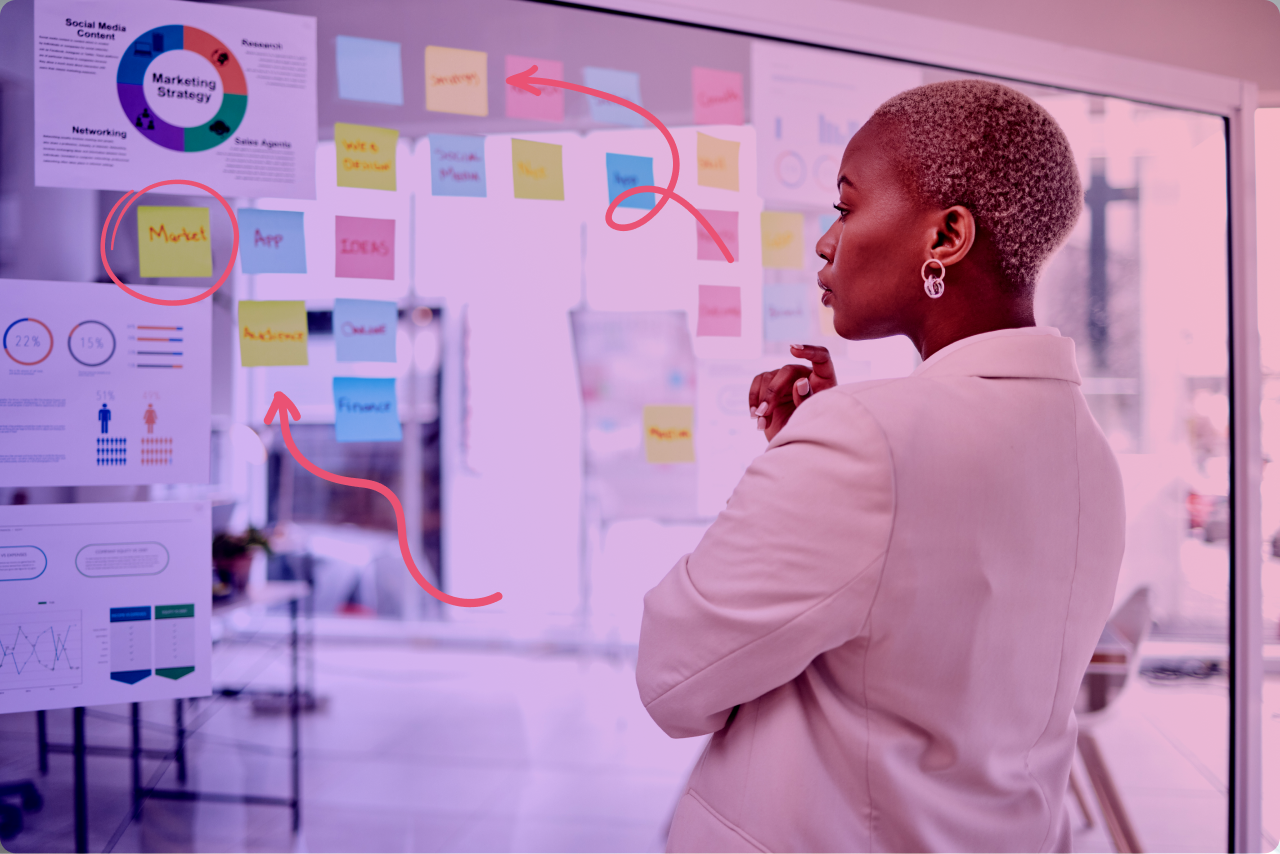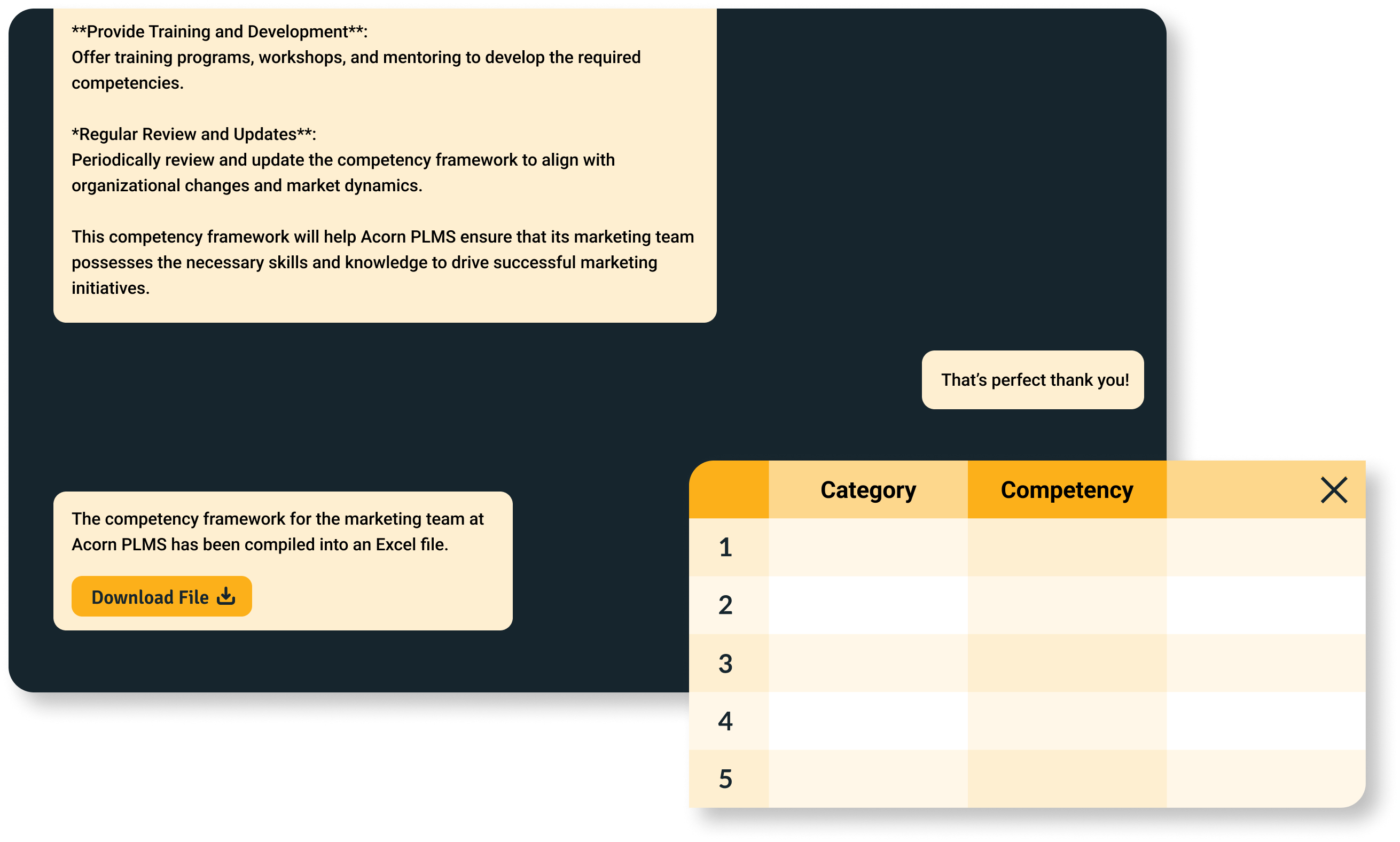How to Map Learning Content to Job Roles for More Impactful Learning and Performance
Reading Time:

Lead the pack with the latest in strategic L&D every month— straight to your inbox.
SubscribeLess is always more when it comes to learning content. If anything, you should put more effort into making content relevant.
If you’ve ever been told to “go and find a course” to develop your skills or knowledge without being given any further guidance, the chances are you were probably frustrated. You don’t know what you don’t know, so how can you be expected to know where to start looking? How can you even know if the course you pick is going to help you?
Enter: Content mapping. It’s the only way to ensure your content strategy is effective. So without further ado, let’s jump into what content mapping is and how you can do to build a stronger L&D process.
What is content mapping?
Content mapping is a strategic process aligning learning materials and resources with the needs and goals of the organization. In learning and development, content mapping ensures that relevant content is delivered to a unique target audience to improve and develop their specific capabilities (the skills, behaviors, knowledge, processes, and tools needed to drive business goals).
Common challenges with content mapping
Content mapping is crucial if you want your employees to learn what’s useful to them. The problem is that for many organizations there’s a focus on having more content to choose from than having the right content. It leads to a paradox of choice that pushes learners towards bad learning decisions, or no decisions at all. This is often a side effect of relying too heavily on generative AI for creating content, which just overstuffs learning catalogs with content that doesn’t apply to most roles.
And having so much content to sort through makes mapping even harder, especially when your learning resources are fragmented across multiple locations. Learning might be stored with specific departments or teams, or maybe your organization makes use of informal learning interactions like coaching. Not having a platform to centralize and map content means you’ll have to handle content mapping efforts manually, which takes up time and resources that could be spent elsewhere.
This becomes a lot harder when content isn’t created or curated with organizational goals in mind. It’s a problem we see pretty frequently: 90% of organizations say L&D focuses on the quantity of content rather than content relevant to their business needs. It means that any content you map to job roles and their assigned capabilities won’t actually have any impact on improving those capabilities, and measuring and analyzing the impact of learning becomes much harder.
When learning is misaligned with goals it’s impossible to prove its return on investment (ROI) because they’re not designed to close specific capability gaps within your business. If you can’t measure performance metrics like KPIs and capability improvement after training is done, then you can use that data to make better strategic decisions for L&D as your company grows.
How to map learning content to job roles
It’s not that hard to create a content map, as long as you build your content strategy with content mapping in mind from the start. There are five steps to creating an effective content mapping process:
- Leverage technology
- Identify capabilities for each role
- Conduct a capability gap analysis
- Create and curate learning content
- Monitor impact and review.
Leverage technology
This is a step zero more than anything. If you use software like a performance learning management system (PLMS), it will have content mapping tools in the system to automate every step of the process. PLMSs use AI to identify and define relevant capabilities to specific job roles, assess training needs, and plan personalized pathways.
With capabilities defined, a PLMS can map those to job roles within your business as well as to the relevant learning content designed to address those capabilities. This is the basis for customizing learning pathways for employees so that they have an outline of learning to be done to guide them. Employees can also track their progress in the PLMS and receive feedback in real-time so that they can continuously improve their capabilities.
Identify capabilities for each role
You can’t identify role-specific capabilities for each role until you have clear job descriptions. Build out detailed job descriptions outlining the responsibilities and tasks for each role. Then you need to break down the capabilities that make those responsibilities possible. So, what skills and knowledge employees need to master to perform their jobs effectively. If you’re using software of some kind (see the step above) then you can use it to build out capabilities for each role based on the job descriptions you input.
The capabilities employees are expected to have will vary due to position and seniority. Obviously, a marketer doesn’t need to know capabilities pertaining to software development. But an entry-level marketer also wouldn’t need to have the same capabilities as senior content marketers. Again, it’s about understanding your target audience, otherwise your content map will be irrelevant to learners.
You can bring in key stakeholders such as managers and team leads here to make sure you cover all your capability bases. HR brings business understanding to the table, but managers and team leads have the boots-on-the-ground understanding of what their employees need to perform their roles. The business and its C-suite have their own pain points (sales revenue, marketing leads, etc.) just as managers have theirs. The point is that assigned capabilities will address those pain points when developed because they’re derived from business goals and strategy.

Try building your own capability framework in less time than it takes to make a cup of coffee with our Capability Assistant.
BUILD YOUR FRAMEWORKConduct a capability gap analysis
Each capability comes with assigned levels of competency. They’re the levelled scale that capabilities are measured by. We recommend having at least three levels covering emerging, proficient, and advanced competency, where emerging competency covers a foundational understanding of the capability and advanced competency is characterized as exceeding expectations.
(P.S. If you need a hint about competency levels, or just want some capabilities with their relevant competencies already, we have a catalog of 600+ capabilities ready to be used. Or if you don’t have any capability framework to drop those capabilities into yet, we have a capability framework building tool you can use too.)
The point of a capability gap analysis is to find out where to target training to ensure that capabilities are being effectively developed in line with business objectives and needs. Your employees might be meeting expectations now, but the business environment is likely to change over time and the level at which they perform their capabilities will have to change with it. So, you need to do a capability assessment to find out where capabilities currently lie, and where they need to be in the future.
We usually recommend doing more than one type of capability assessment to get the most objective overview of competencies. Self-assessments are useful, but are difficult in the sense that while some people have a pretty clear idea of what they can and can’t do, others have a blind spot (or are needlessly critical) when it comes to their capabilities. So, it’s always best to pair that with an assessment from managers who have a clearer idea of business objectives and how individuals’ performance plays into that.
Make sure you keep in mind that an “emerging” competency isn’t necessarily a bad thing. Let’s go back to our marketing analogy. You’d want your content marketer to have a deep understanding of buyer personas and the buyer’s journey when they launch their marketing campaigns. But your entry-level marketer won’t need to have that level of understanding at that point in their career. You can help develop them to that point, sure, but for now it’s just not a high priority for them to worry about.
Similarly, industry changes (whether due to new tech, processes, or standards) will change what capabilities people need to have over time. No one in 1995 expected their marketing team to have a social media strategy, but ten years later social media posts were the crux of entire marketing campaigns. Times change, and so too will the gaps in current and needed capabilities, so make sure you identify gaps and prioritize what needs to be closed first. This forms the basis of individual learning pathways. Maybe you want to develop employees as part of a succession plan, or you just want employees to gain a deeper understanding of their roles. These capability gaps will guide where you should target personalized content.
Curate and create learning content
This is where the pesky issue of content overload can rear its head again. Content creation isn’t terrible, per se—sometimes custom content is necessary to address niche topics, after all—but you need to be considered and intentional with it. 40% of learners say they can’t find what they need because their learning catalogs are overloaded. This is why we don’t push the “create content” narrative—instead we say “curate, curate, curate”.
What do we mean be this? Make sure you deliver content that’s relevant to users and user behavior. It’s all about aligning content with the specific roles you have. Your sales and customer support teams will need informational content on the customer journey or customer lifecycle so that they can build better customer relationships (and keep those customers on board, which is important for your bottom line). Sales and marketing need to understand detailed buyer personas and how each stage of the buyer’s process works.
As we mentioned earlier, it’s all about identifying that intended audience and making sure content resonates with their specific needs. That way, employees improve their job performance and contribute value to the business. You can automate this particular process with a PLMS, because it can identify what content develops which capabilities and assign that learning to employees based on their individual development plans.
Monitor impact and review
Content mapping is important to making sure employees receive the right training to improve their performance, but if you aren’t mapping the right content then you’re wasting time and resources. If there’s no performance improvement or changes in behavior or actions from employees following training, then it may not have been the right content for the target audience and will need to be adjusted.
Think about training ROI here to get tangible numbers on performance improvement. Software can also streamline this process—PLMSs in particular can deliver employee performance evaluations, providing invaluable insights into the effectiveness of learning.
And don’t forget to provide regular check-ins and feedback with learners. Part of monitoring the impact and efficacy of learning—and ensuring long-term performance improvement—is giving—learners a change to course-correct in the moment. It’s the best way to ensure that learners get the most out of their own content map and development plans.
Key takeaways
Making sure employees have the right pathways to success is what makes content mapping important. Learners want to develop their capabilities to get better at their roles, but they can only do that with content that develops those capabilities (something that the push for more learning actively prevents).
Just remember to be intentional with content mapping—developing competency in capabilities is crucial for performance improvement, but not all capabilities need to be developed at once. Prioritizing which capabilities to target and when is just as important as content mapping to capabilities.